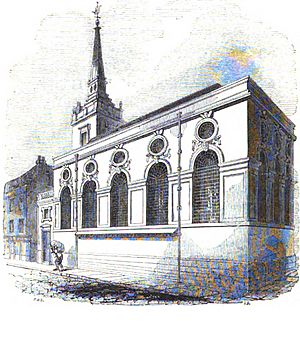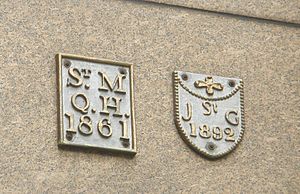St Michael Queenhithe facts for kids
Quick facts for kids St. Michael Queenhithe |
|
|---|---|
 |
|
| Location | Upper Thames Street, Queenhithe, City of London |
| Country | United Kingdom |
| Denomination | Church of England |
| Architecture | |
| Architect(s) | Christopher Wren |
| Style | Baroque |
| Demolished | 1876 |
St. Michael Queenhithe was a historic church located in the City of London. It stood on what is now Upper Thames Street. People first wrote about this church in the 1100s.
Sadly, the church was destroyed in the terrible Great Fire of London in 1666. It was later rebuilt by the famous architect Christopher Wren and his team. However, the church was eventually taken down in 1876.
A Look Back: The Church's Story
In the Middle Ages, London had seven churches named after the Archangel Michael. Five of these churches were rebuilt after the Great Fire. The area where St. Michael Queenhithe stood is still called Queenhithe today. There is also a dock on the River Thames nearby with the same name.
The church was first mentioned in the 12th century. Back then, it was called St Michael Aedredeshuda. This was an older name for Queenhithe. It was also known by other names like St Michael upon Thames.
A writer named John Stow once described the church. He said it was "a convenient church." But he also noted that "all the monuments therein are defaced." This means any memorials inside were damaged or removed.
During the Great Fire of London, the church was caught in the flames. King Charles II and his brother, the future King James II, watched the fire. They saw many buildings, including churches, burning. St. Michael Queenhithe was soon destroyed.
The church was rebuilt between 1676 and 1686. Some of the old walls were used again. The cost to rebuild was about £4375. This was a lot of money back then! The church's area, or parish, was joined with another church's. This was the parish of Holy Trinity the Less. That church was also destroyed in the fire but was never rebuilt.
A famous painter, Sir James Thornhill, helped decorate this church. He was known for painting the ceilings of St Paul's Cathedral. In 1721, he helped fix and improve the painting near the altar. Sadly, this painting was later destroyed.
In 1779, a new organ was put into the church. It was made by George England and Hugh Russell.
By the late 1800s, many people moved out of the City of London. Because of this, the church was no longer needed as much. The last service was held in December 1875. The church was taken down in 1876. This happened under a law called the Union of Benefices Act 1860. The church's parish was then joined with St James Garlickhythe. Many of St. Michael Queenhithe's church items were moved there. The money from selling St. Michael Queenhithe's land helped build St Michael's Church, Camden Town.
Today, part of the old church site is under Upper Thames Street. A footbridge crosses over this spot. The old churchyard is now under a building called Fur Trade House. There are plans to build a hotel in this area.
How the Church Looked
St. Michael Queenhithe had its main entrance facing south and east. These sides looked towards the Queenhithe dock. The church was five sections long from east to west. It was three sections long from north to south. The lower windows were rounded at the top. Circular windows were above them.
The entrance area and a small room for the clergy (called the vestry) were built a bit lower.
The church's tower was on the northwest corner. On top of the tower was a steeple. It looked a bit like a ziggurat, which is a stepped pyramid. It had five steps going up on four sides. From the top platform, a pointed lead spire rose up.
At the very top of the spire was a weather vane. This vane was shaped like a three-masted ship. This type of ship was used to carry corn. This was a nod to the main goods unloaded at the nearby dock. Just below the ship was a brass ball. It was big enough to hold a bushel of grain.
After the church was taken down, the ship-shaped vane stayed. It sat on a small spire. In 1962, it was moved to the top of St Nicholas Cole Abbey. It is still there today.


